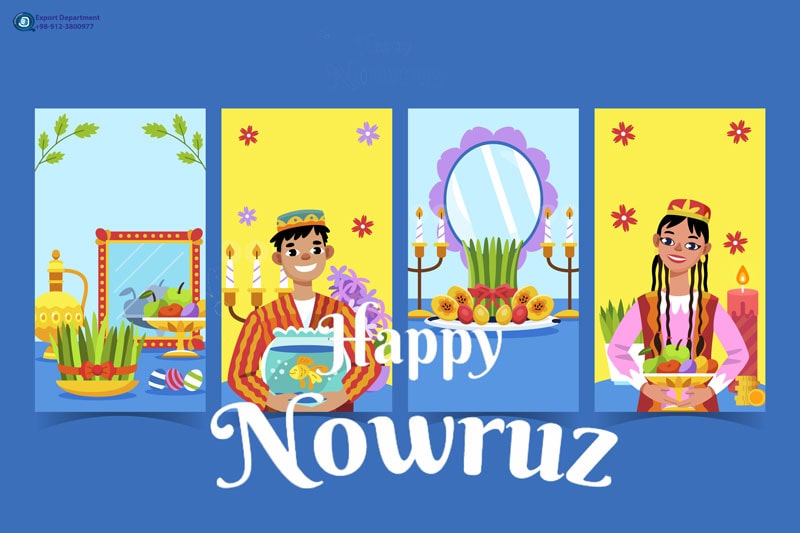
International Celebration of Nowruz
Nowruz, listed on the Representative List of the Intangible Cultural Heritage of Humanity since 2009, embodies the renewal of nature and fosters peace, solidarity, and reconciliation within families and across generations. Celebrated worldwide, it heralds the onset of spring on March 21st, marking the new year for over 300 million people across diverse regions and cultures for over 3,000 years. Our team at Export Department, an expert in the dairy sector, is thrilled to present you with cutting-edge insights.
Nowruz Ceremony
The international Nowruz festival in Iran starts with Charshanbe Suri and ends with Sizdah Bedar.
Night of Charshanbe Suri
During Chaharshanbe Suri night, a precursor to the New Year celebrated on the eve of the last Wednesday before Nowruz, Iranians leap over fires while reciting the poetic line "my yellowish is yours, your reddish is mine," symbolizing a desire to cast away illness and receive warmth, health, and energy in return. Additionally, nuts and berries are commonly served during the celebration. Another tradition observed on the eve of Chaharshanbe Suri is "spoon banging," reminiscent of the Halloween custom of trick-or-treating.
Sizdah Bedar
Nowruz holidays in Iran span thirteen days. On the thirteenth day, known as Sizdah Bedar, Iranians go to parks or out of the city for picnics and to connect with nature. As part of the ceremony, the greenery used in the Haft-sin setting is disposed of, often in flowing water. It is a tradition, especially among young single individuals, to tie the leaves of the greenery before discarding them, symbolizing a wish to find a partner. Additionally, Sizdah Bedar is marked by playful pranks and jokes, reminiscent of April Fools' Day.
Cleaning and Shopping
Preparing for Nowruz typically involves two main tasks: house cleaning and shopping. Prior to the arrival of Nowruz, people engage in a thorough spring cleaning of their homes, ensuring everything is fresh and tidy for the New Year. Additionally, individuals purchase new clothes to wear during the celebrations and buy flowers, with hyacinths and tulips being popular choices for the traditional Haft-sin setting.
Visiting Family and Friends
Throughout the Nowruz holidays, it is customary for people to make visits to the homes of family, friends, and neighbors. Usually, younger individuals initiate visits to their elders, who reciprocate later. Guests are welcomed with tea, pastries, cookies, fresh and dried fruits, mixed nuts, or other snacks
Nowruz Food Preparation
During Nowruz, traditional dishes like dill rice with fish and sweets like Nan-e Nokhodchi are enjoyed. Samanu, made from wheat germ, is another customary dish cooked in many regions, with unique preparation rituals in different countries like Iran, Afghanistan, Tajikistan, Turkmenistan, and Uzbekistan, often cooked by women and girls accompanied by songs and chants.
Haft-sin
Traditionally, prior to Nowruz, families gather around the Haft-sin table, eagerly awaiting the exact moment of the March equinox to usher in the New Year. The number 7 and the letter S hold significance, representing the seven Amesha Spenta’s from the Zend-Avesta, which correspond to the elements of Fire, Earth, Air, Water, and the life forms of Humans, Animals, and Plants. In modern interpretation, the Haft-sin items are simplified to include Sabze (sprouts of wheat, barley, mung beans, or lentils grown in a dish), Samanu (a sweet pudding made from wheat germ), Oleaster (senjed in Farsi), Vinegar (serke in Farsi), Apple (sib in Farsi), Garlic (sir in Farsi), and Sumac (somāq in Farsi). Additionally, the Haft-sin table may feature a mirror, candles, painted eggs, a bowl of water, goldfish, coins, hyacinth, and traditional sweets, along with a "book of wisdom" such as the Quran, the Šāhnāme of Ferdowsi, or the divān of Hafez.
.png)
In 2010, the UN General Assembly declared International Nowruz Day (resolution A/RES/64/253), led by countries including Afghanistan, Azerbaijan, Iran, and Turkey, promoting peace and cultural unity.
